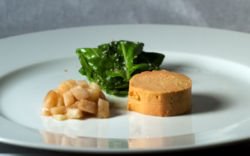 Olive Garden (multiple locations)
Olive Garden (multiple locations)
1/2 SPORKI've always loved the TV commericals where "Uncle Giovanni" comes over from Italy and his family takes him to an Olive Garden, which, he
loves, making all those Ragu-stereotypical Italian "mama mia thazza spicy meata ball!" hand gestures. Some family, right? Either Uncle Giovanni has just been furloughed from an Italian prison, or his family are total assholes.
Television advertising, however, works on me. So for months now I've been prodding Spoon to dine with me at an
Olive Garden just blocks from her apartment in Manhattan. To her credit, she resisted, even ridiculed the suggestion. Eventually, however, she began to see my point: in a city with so much fine, authentic Italian food, eschewing the multitude of excellent family trattorias for the OG could offer a perverse culinary thrill. And we're nothing if not thrillseekers.
Tonight we finally made our pilgrimage to the OG. And let's just say I likely would've preferred an authentic meal eating soap flakes and drinking homemade "wine" from the toilet of Uncle Giovanni's Italian prison cell. Our dining experience at Olive Garden was everything we thought it wouldn't be. And so much less.
The OG experience began with three young hostesses creating a standing room only line for a restaurant full of empty tables. After almost 10 minutes of waiting, with the strains of opera lilting through the restaurant, (how, um, authentic) a pimply teen led us to a table for four smack in the middle of the room. Having just come from our gym, we had hoped for something a bit more secluded. So we rocked the poor kid's world and asked if we could move to an empty booth a few feet away that was set up for two. "Uh...hold on," he said, pubescent voice crackling. After at least five more minutes standing with coats in hand in the middle of the room our thoughts turned dark: can the humans defeat the seating software?
Eventually, the OG executive hosting committee found the override codes and we were shown to our booth. After another five or ten minutes our first waiter showed up with a bottle of the OG's own rose wine. "This is made exclusively for Olive Garden," our waiter, Marvin, informed us. I envisioned Uncle Giovanni barefoot, swilling from the bottle (ahhhhh...tutto bene!). Marvin poured us two samples. We swirled our glasses, breathed the wine's essence, held it to the light and tasted. I got toenails. Driftwood. Porcelain. A hint of soil...perhaps, Chia Pet? We declined.
The room itself, despite clearly coming from a kit-box labeled
ITALIAN RISTORANTE, was not altogether objectionable. The tables were spaced widely apart, which succeeded in muting other diners' conversations, like:
"Does your food taste like shit?"
"Yes, like shit."
"I think this mushroom might actually be a piece of shit."
"I think you're right. It's a little piece of shit."
After a period of attempting to read the lips of nearby diners it dawned on us that Marvin had pretty much disappeared. It wasn't hard to figure out why: the menu states that all tips are automatically included in the checks, calculated at 15 percent, the perfect incentive for a waiter to work just hard enough not to get fired. Despite his inattentiveness, we liked Marvin, what little we saw of him. He seemed like he was probably a good student.

When Marvin eventually returned he brought with him the Olive Garden's signature dish: free bread sticks! A basket of two phallic, warm, chewy mini-loaves of bread clearly pumped with so much bleached flour and preservatives they could stay soft through the next ice age.
The OG menu itself was entertaining. General observations: the trans-fat ban in New York could destroy the appetizer section. The "Italian antipaste" was literally a plate of fried food. The special appetizers that night included a mozzarella "fonduta," essentially a bowl of melted cheese you dip bread into, and an artichoke dip, a big, sloppy boat of warm, greenish gruel surely plopped out from canned ingredients.
We did not dare try the specials. Instead, we ordered a refillable salad bowl and a bowl of soup called
Zuppa Toscana. The Salad was fine, delicious, actually. An iceberg lettuce base with canned olives and red onion, albeit, but it was lightly dressed and rather cool and crisp. It was no question the best thing on the table all night, especially the tomatoes, which were soft and flavorful, as good as I've had anywhere in the city. The half-star review earned by the OG in our review was earned right there by the tomatoes.
The soup, on the other hand, was a gray, Campbell's-like creation with shredded bits of what i'm guessing was sausage, sliced potatoes, and flecks of a kale-like weed. The soup's key ingredient was salt: it had the salinity of movie popcorn.
For dinner, we opted to play it safe. Spoon had a cappellini pomodoro. While we could discern some fresh ingredients (it was a pomodoro after all) fresh ingredients don't prepare themselves and can still taste like shit, epsecially when prepared by a disinterested, underpaid ex-con line cook working from an Italian recipe supplied by an American mass-market fast-food corporate bohemoth. Spoon's pomodoro sucked. There it is. Not much nuance to add, it just totally...fucking...
sucked. The pasta was badly cooked, clearly boiled once, rinsed, cooled, then re-boiled before serving. The sauce looked like someone had run a lawn mower through your nonna's garden and tossed a fistful of the mulch onto a plate.
I had spaghetti and meatballs, not even really an Italian meal, to tell the truth, but then Olive Garden isn't really an Italian restaurant so the order made some kind of twisted sense. My plate was positively institutional. The sauce tasted like the kind you'd drill from a can in any school cafeteria or jail. It was a meal I would've expected to eat in a bomb shelter. The meatballs were gray, hard, possibly microwaved and tasted of the lowest low-grade ground chuck. Luckily, we were ignored by the waitstaff long enough to skip the clearly non-Italian desserts, mostly syrup-strewn cheescakes and chocolate.
Is there a way to do the Olive Garden...and survive? In an interview, food writer Steven Shaw told Spoon he once dined at an Olive Garden while stranded in some backwater burg and made a decent meal out of the soup, salad and breadsticks. Famous Italian chef Marcella Hazan, however, who once accepted a sadistic invitation from
USA Today to eat and critique the Olive Garden, hit the nail on the head.
Hazan slammed the food. That's a given. It tastes like shit and you don't need to be a legendary Italian chef to know shit when you eat it. But Hazan declined the low-hanging fruit and rather than bash the food for being shit, she derided the OG's very existence embodied in their penchant for creating fake Italian dishes as an excuse to drench things like a chicken breast or a steak in four cheeses and olive oil. "There are 60,000 recipes in Italy." Hazan told USA Today, the Olive Garden of American newspapers. "Why do they have to invent new ones?" --F

 Baguettes, croissants, brioches, camemberts, chevres, St. Marcellens, macarons, mille-feuilles, buches de Noel (tis the season!)... I ate them all. Bonnes fetes.--S
Baguettes, croissants, brioches, camemberts, chevres, St. Marcellens, macarons, mille-feuilles, buches de Noel (tis the season!)... I ate them all. Bonnes fetes.--S








